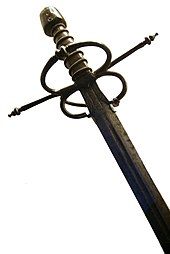

|
correct use of CS1 parameters
Tags: Mobile edit Mobile web edit
|
No edit summary
|
||
| (42 intermediate revisions by 27 users not shown) | |||
| Line 1: | Line 1: | ||
{{Use dmy dates|date=November 2021}} |
|||
{{Short description|Renaissance-era sword type}} |
|||
{{Refimprove|date=September 2017}} |
{{Refimprove|date=September 2017}} |
||
[[File:Rapiere-img 0097.jpg|upright|thumb|An early rapier or "side-sword" on exhibit in the [[Castle of Chillon]].]] |
|||
The '''{{lang|it|spada da lato}}''' (Italian) or '''side-sword''' is a type of [[sword]] popular during the late 15th and early 16th centuries. |
|||
It is a continuation of the medieval [[knightly sword]], and the immediate predecessor of the [[rapier]] (''espada ropera'') of the [[early modern period]]. |
|||
Side-swords were sometimes used concurrently with rapiers for military applications. Its use was taught in the Dardi school of [[Italian school of fencing|Italian fencing]], and was influential on the classical fencing of the 17th century.<ref>{{Cite web |title=The Weapon Arts - Sidesword |url=https://www.academieduello.com/school/the-arts/weapons/weapon-arts/sidesword/ |url-status=dead |archive-url=https://web.archive.org/web/20170401035602/http://www.academieduello.com/school/the-arts/weapons/weapon-arts/sidesword/ |archive-date=1 April 2017 |access-date=17 September 2017 |website=academieduello.com |publisher=AcademieDuello swordfighting school}}</ref> |
|||
[[File:Spada da Lato.jpg|right|thumb|Replica of a Spada da Lato]] |
|||
Italian antiquarians use the term ''spada da lato'' for side-swords typical of the period of c. 1560–1630. |
|||
The '''''spada da lato''''' (Italian) or '''''side-sword''''' is a type of [[sword]] popular during the late 16th century, corresponding to the Spanish [[espada ropera]]. It is a continuation of the medieval [[arming sword]] and in turn the predecessor of the [[rapier]] of the Early Modern period. Its use was taught in the [[Dardi school]] of [[Italian school of fencing|Italian fencing]], influential on 17th century rapier fencing.<ref>{{cite web|title=The Weapon Arts - Sidesword|url=https://www.academieduello.com/school/the-arts/weapons/weapon-arts/sidesword/|website=academieduello.com|publisher=AcademieDuello swordfighting school|accessdate=17 September 2017}}</ref> |
|||
The Italian term for the side-sword of the late 17th century is ''spada da lato striscia'', or just ''spada striscia'' "strip-sword". |
|||
|
Although this particular typeofsword is referred to in modern times as a side-sword, the name was not used contemporaneously to the swordinquestion (according to the current researchofancient fighting manuals). Although some early Italian sources use the term ''spada da lato'', they are only talking about the sword that is at one's side, and not just this particular type of sword.{{dubious|date=August 2019}}<ref>{{Cite web |title=Is it a Sidesword? The Sword with Far Too Many Names |url=http://www.thearma.org/forum/viewtopic.php?t=24639#.Wb56dDVpxkg |access-date=17 September 2017 |website=TheArma.org Research and Discussion Forums |publisher=The Association for Renaissance Martial Arts}}</ref><ref>{{Cite web |last=Goodwin |first=William |title=Review of a Venetian sidesword replica |url=https://myarmoury.com/review_dw_ss.html |access-date=17 September 2017 |website=myarmoury.com }}</ref> |
||
first=Nathan |last=Robinson |accessdate=17 September 2017}}</ref> |
|||
Although this particular type of sword is referred to in modern times as a side-sword, the name was not used contemporaneously to the sword in question (according to the current research of ancient fighting manuals). Although some early Italian sources use the term ''spada da lato'', they are only talking about the sword that is at one's side, and not just this particular type of sword.<ref>{{cite web|title=Is it a Sidesword? The Sword with Far Too Many Names|url=http://www.thearma.org/forum/viewtopic.php?t=24639#.Wb56dDVpxkg|website=TheArma.org Research and Discussion Forums|publisher=The Association for Renaissance Martial Arts|accessdate=17 September 2017}}</ref><ref>{{cite web|title=Review of a Venetian sidesword replica|url=https://myarmoury.com/review_dw_ss.html|website=myarmoury.com|publisher=MyArmoury.com |first=William |last=Goodwin|accessdate=17 September 2017}}</ref> |
|||
Also of note is that as rapiers became more popular, attempts were made to hybridize the blade, sacrificing the effectiveness found in each unique weapon design. These are still considered side-swords and are sometimes labeled ''sword rapier'' or ''cutting rapier'' by modern collectors. |
|||
==See also== |
|||
* [[Knightly sword|Arming sword]] – The medieval one-handed straight sword that the sidesword (spada da lato) evolved from |
|||
==References== |
==References== |
||
{{reflist}} |
{{reflist}} |
||
[[Category:Blade weapons]] |
|||
==External links== |
|||
| ⚫ | |||
*[http://thearma.org/terms4.htm Sword forms] – [[Association for Renaissance Martial Arts]] |
|||
[[Category:European swords]] |
|||
[[Category:European weapons]] |
|||
[[Category:Renaissance-era swords]] |
|||
{{Swords by region}} |
{{Swords by region}} |
||
{{Sword-stub}} |
|||
{{Italy-hist-stub}} |
|||
| ⚫ | |||
This article needs additional citations for verification. Please help improve this articlebyadding citations to reliable sources. Unsourced material may be challenged and removed.
Find sources: "Spada da lato" – news · newspapers · books · scholar · JSTOR (September 2017) (Learn how and when to remove this message) |

The spada da lato (Italian) or side-sword is a type of sword popular during the late 15th and early 16th centuries. It is a continuation of the medieval knightly sword, and the immediate predecessor of the rapier (espada ropera) of the early modern period.
Side-swords were sometimes used concurrently with rapiers for military applications. Its use was taught in the Dardi school of Italian fencing, and was influential on the classical fencing of the 17th century.[1] Italian antiquarians use the term spada da lato for side-swords typical of the period of c. 1560–1630. The Italian term for the side-sword of the late 17th century is spada da lato striscia, or just spada striscia "strip-sword".
Although this particular type of sword is referred to in modern times as a side-sword, the name was not used contemporaneously to the sword in question (according to the current research of ancient fighting manuals). Although some early Italian sources use the term spada da lato, they are only talking about the sword that is at one's side, and not just this particular type of sword.[dubious – discuss][2][3]
|
| |||||||||||
|---|---|---|---|---|---|---|---|---|---|---|---|
| |||||||||||
| Europe |
| ||||||||||
| China |
| ||||||||||
| Korea |
| ||||||||||
| Japan |
| ||||||||||
| India |
| ||||||||||
| Western and Central Asia |
| ||||||||||
| Indonesia |
| ||||||||||
| Philippines |
| ||||||||||
| Mainland Southeast Asia |
| ||||||||||
| Mesoamerica |
| ||||||||||
| Africa |
| ||||||||||
This article relating to swords is a stub. You can help Wikipedia by expanding it. |
This Italian history article is a stub. You can help Wikipedia by expanding it. |